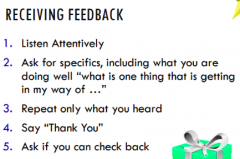![]()
![]()
![]()
Use LEFT and RIGHT arrow keys to navigate between flashcards;
Use UP and DOWN arrow keys to flip the card;
H to show hint;
A reads text to speech;
14 Cards in this Set
- Front
- Back
|
Discuss the essential components of effective patient centered communication (key terms! NOT steps!) |
Verbal / non-verbal communication (look for cues! & watch your own presentation) Obtain / Give info Interpersonal collaboration Interpersonal sensitivity Silence > allow time for patient to decode, summarize & encode info Open-ended questions Clinical Competence Professionalism Respect Sincere Interested / Eager to help / Empathy Openness & Receptive to Feedback Avoid jargon |
|
|
Patient Centered Communication = steps? |
a) Introduce yourself, verify patient’s name, establish rapport with patient, confidentiality, sit an agenda, sit at same height b) Client Centered Interview phase: chief complaint, medical/dental history & family history - ask about dental anxiety / negative dental experiences - inquire about habits (grinding, clenching, cheek biting, nail biting) & associated symptoms - oral health habits (diet, frequency of eating, Fl toothpaste, floss, type of toothbrush) c) Dentist Centered Interview phase: obtain personal/social history, inquire about acquired risk factors & BELIEFS ABOUT ORAL HEALTH d) Ask if patient has additional concerns or questions. Summarize your findings. Include the closing statement (which includes the steps of what you will need to do next) |
|
|
Name what kind of biomedical information you want to collect |
Med / Dent Hx Work status Family status Recent changes in lifestyle Stressors Habits (illicit drugs, exercise, drinking) |
|
|
Explain in detail the appropriate way to open the interview. |
Make eye contact Call the patient (not first name unless permission) Affirm confidentiality & establish rapport (sit at the same level as the patient) Ask them what brings them to your office CC > open-ended q's, silence |
|
|
Explain in detail the appropriate way to close the interview |
Summarize info provided "I understand that your most important concern....You have expressed your anxiety & concern for the cost of the treatment" Make sure that you & patient are on the SAME page with apptmt & plan of action Ask patient if they have any concerns / q's Discuss next steps & that you'll be there for them |
|
|
Cultural Safety / Sensitivity = factors you wanna run through (?????))) |
FEELINGS related to the illness/symptoms What are your concerns / specific fears? IDEAS / explanations for the cause What do you think is going on? FUNCTIONING How has it impacted your day to day life? EXPECTATIONS of the dental team Address the patient's request |
|
|
Define: Communication Climate |
Emotional tone of a relationship between 2 or more individuals |
|
|
Confirming vs Disconfirming Communication? Provide examples |
CONFIRMING = express care / respect for another person eg. recognition, acknowledgement, endorsement DISCONFIRMING = lack of care / respect for another person eg. impervious, interrupting, irrelevant, tangential, impersonal, ambiguous, incongruous |
|
|
Disagreeing messages? Ex? |
Express, "you are wrong" - aggressiveness - complaining - argumentativeness |
|
|
Name the 6 Gibb's Categories |
Defensive > Supportive Behaviour Evaluation > Description Control > Problem orientation Strategy > Spontaneity Neutrality > Empathy Superiority > Equality Certainty > Provisionalism |
|
|
Examples of Negative & Positive Reciprocal Patterns |
Negative: - complaint > counter-complaint - disagreement > disagreement - mutual indifference - arguments involving punctuation (LOL) Positive: - validation of other's perspective - recognize similarities - supportiveness |
|
|
Steps for ELICITING FEEDBACK |

|
|
|
Steps for RECEIVING FEEDBACK |

|
|
|
Steps in GIVING FEEDBACK (include the script) |
1) Prepare yourself 2) Set the Stage 3) Describe the situation & behaviour > WHEN... 4) Discuss the impact of behaviour (on coworkers, organization, "I feel concerned about" etc) & your intentions using "I" language I FEEL..... 5) Ask for change (discuss + & -) SO I'D LIKE.... 6) How is that for you? Plan for change. HOW.... 7) Thank you 8) Follow Up |

